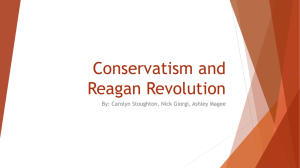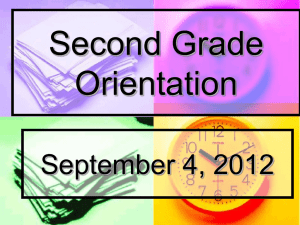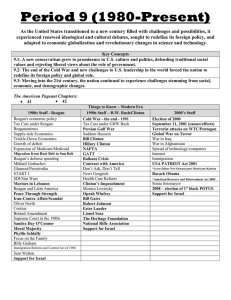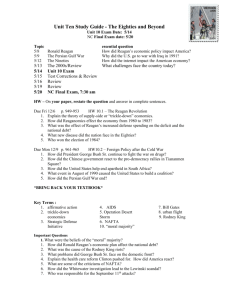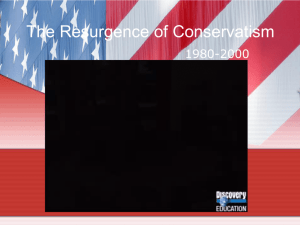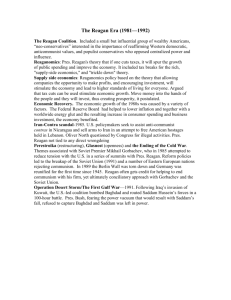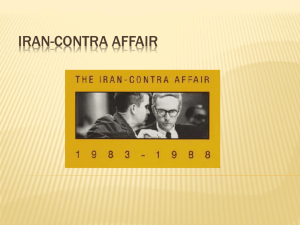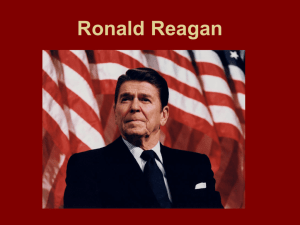Reagan’s “Gender Gap” Strategy and the Limitations of Free-Market Feminism
advertisement
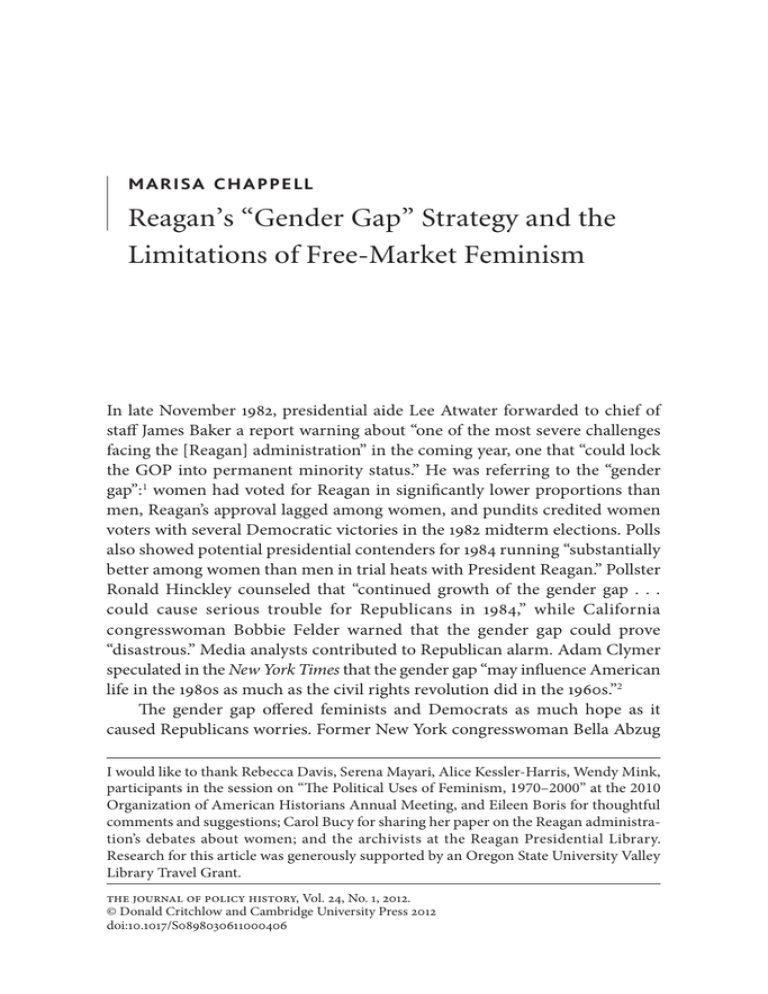
marisa chappell Reagan’s “Gender Gap” Strategy and the Limitations of Free-Market Feminism In late November 1982, presidential aide Lee Atwater forwarded to chief of staff James Baker a report warning about “one of the most severe challenges facing the [Reagan] administration” in the coming year, one that “could lock the GOP into permanent minority status.” He was referring to the “gender gap”:1 women had voted for Reagan in significantly lower proportions than men, Reagan’s approval lagged among women, and pundits credited women voters with several Democratic victories in the 1982 midterm elections. Polls also showed potential presidential contenders for 1984 running “substantially better among women than men in trial heats with President Reagan.” Pollster Ronald Hinckley counseled that “continued growth of the gender gap . . . could cause serious trouble for Republicans in 1984,” while California congresswoman Bobbie Felder warned that the gender gap could prove “disastrous.” Media analysts contributed to Republican alarm. Adam Clymer speculated in the New York Times that the gender gap “may influence American life in the 1980s as much as the civil rights revolution did in the 1960s.”2 The gender gap offered feminists and Democrats as much hope as it caused Republicans worries. Former New York congresswoman Bella Abzug I would like to thank Rebecca Davis, Serena Mayari, Alice Kessler-Harris, Wendy Mink, participants in the session on “The Political Uses of Feminism, 1970–2000” at the 2010 Organization of American Historians Annual Meeting, and Eileen Boris for thoughtful comments and suggestions; Carol Bucy for sharing her paper on the Reagan administration’s debates about women; and the archivists at the Reagan Presidential Library. Research for this article was generously supported by an Oregon State University Valley Library Travel Grant. the journal of policy history, Vol. 24, No. 1, 2012. © Donald Critchlow and Cambridge University Press 2012 doi:10.1017/S0898030611000406 116 | Reagan’s “Gender Gap” Strategy saw the gap as “indicative of a long-range trend toward the development of a distinctive issue-oriented women’s voting bloc” and predicted that woman voters would “defeat Reagan, Reaganomics, and Reagan Republicanism” in 1984.3 The Democratic Party certainly hoped so, and went out of its way to show that it “stands for and with the women of America.” Presidential contenders vied for women’s support, while the party targeted women with voter registration campaigns, gave women’s organizations a key role in shaping the platform, and selected a woman—Geraldine Ferraro—as its vice presidential candidate.4 The respective fears and hopes surrounding the gender gap in the early 1980s reflect over a decade of profound social, economic, and cultural change in women’s roles and family structure, rapid shifts in public policy and law as a result of feminist activism, and the political mobilization of a “New Right” committed to reversing these changes. They are also a product of the gender gap’s novelty. While women had supported the “‘less radical’ and/or more ‘caring’ candidate” since the 1950s, in 1980, “the gender gap began to manifest itself along ideological and partisan lines.” Women, an administration report warned, “are now emerging as considerably more liberal and Democratic than men.” And 1980 was the first year that women voted in equal proportion to men; this new voting power fueled fear that the gender gap would generate a political turning point much different from the “Reagan Revolution” that conservatives envisioned.5 Analysis of the Reagan administration’s response to the gender gap not only illuminates the influence of second-wave feminism but also suggests that gender played a more complicated role in conservative politics than many scholars have contended.6 During the 1970s, anxieties about changes in sexual behavior, gender roles, and family structure fueled the development of a “New Right,” which mobilized voters around the so-called social issues: prayer in public schools, sex education, and especially abortion and the ERA. Phyllis Schlafly’s Stop ERA, Jerry Falwell’s Moral Majority, and dozens of other organizations of socially conservative voters gained a disproportionate influence over electoral politics and provided an energetic base of support for Reagan. But if “‘profamily,’ antifeminist politics . . . was central to Reagan’s platform,” as political theorist Zillah Eisenstein has contended, Reagan offered little more than rhetorical support on New Right social issues, spending political capital instead on implementing his vision of free-market capitalism through tax cuts, social spending cuts, and deregulation—policies generally supported by New Right voters, to be sure, but not their top priorities.7 marisa chappell | 117 If Reagan’s election marked the end of a viable “Republican feminism,” as historian Catherine Rymph has argued, it did not mean complete victory for antifeminism either.8 The Reagan administration’s alarm over the gender gap suggests that Americans’ widespread commitment to equal rights and equal opportunities for women played a role in constraining the policy influence of traditionalist conservatives. It also challenges a portrait of gender politics rooted in simple binaries—feminism versus antifeminism. Much like “color-blind conservatism,” which rejected both overt racism and government efforts to overcome racial inequality, the Reagan administration’s free-market feminism adopted the feminist movement’s rhetoric of equal opportunity and choice while denying the need for federal intervention to promote gender equality.9 The administration ultimately blamed the gender gap on women’s changing economic role: their growing rate of labor market participation and their economic vulnerability amid the collapse of the family wage system. It hoped to address the problem in a manner consistent “with the basic principles of the Reagan philosophy, e.g. reduced federal spending [and] reduced tax and regulatory burdens.”10 Hewing to the narrowest interpretation of liberal feminism, the administration promised that formal legal equity and a growing economy would ensure equal economic opportunity. This rhetorical commitment to formal fairness in the marketplace, or free-market feminism, was a far cry from the position of even the most mainstream feminist organizations, which insisted on the need for active government intervention to achieve meaningful equality. In the end, the administration offered rhetorical support and a few benefits to economically secure women—those considered a good prospect for Republican recruitment. But in supporting retreat from active enforcement of equal opportunity, affirmative action, and welfare-state supports, free-market feminism failed to address the “real gender gap”—the gap that continued to keep women more economically vulnerable than men. Meanwhile focus on the gender gap ignored divisions among women, that is, the relative privilege of some women over others, predominantly workingclass and racial/ethnic minority women, to take advantage of market-based opportunity. diagnosing the problem: the “quiet revolution” In August 1982, as pundits predicted that women voters would provide the margin of victory for Democrats in key congressional races that November, Reagan appointed a seven-member White House Coordinating Council on 118 | Reagan’s “Gender Gap” Strategy Women, chaired by Elizabeth Hanford Dole, Assistant to the President for Public Liaison. That fall, the council heard “extensive briefings from pollsters, demographers, market analysts, and organizational leaders,” suggestions from numerous administration officials, and surveys conducted for the Republican National Committee, Census Bureau data, and published election analyses.11 It quickly dismissed two commonly cited explanations for women’s disaffection: Reagan’s positions on the Equal Rights Amendment (ERA) and abortion, and his hawkish foreign policy stance. It is a “myth,” insisted pollster Dick Wirthlin, that “women don’t like Reagan because of his positions on Women’s Rights,” by which he meant abortion and the ERA. True, a majority of women supported the ERA and reproductive choice, but so, too, did a majority of men; there was no gender gap on these issues, and they appeared to play little role in voting preferences. At any rate, the council saw little hope of winning over the most vocally feminist women. It considered young and baby-boom women who “want to actively change the role of women in society” a “low probability population” for the administration’s appeals and determined that “the development of policies simply to appease the feminist advocates would be counter-productive.”12 Journalists, pundits, and feminist analysts also targeted Reagan’s hard-line Cold War rhetoric and increased defense budgets as one cause of the gender gap, and several pollsters concurred.13 Unlikely to convince Reagan to alter his foreign policy paradigm, his aides dismissed women’s concerns as misguided. Hinckley advised that “belligerent, bellicose, or aggressive statements will tend to increase the gap,” and the council merely suggested strategy to correct women’s supposed misperceptions and to ensure that “the Administration communicates its philosophy in language that women can respond to.”14 The council also hoped that emphasizing the president’s softer side would win over more women. Reagan’s “personality and style,” as a “man’s man,” it suggested, had contributed to the gender gap. Some aides suggested “more feminine input into the speechwriting process” and ensuring that all White House communications were “sensitized” to the “apparent fact that women and men receive messages differently.”15 Citing Carol Gilligan’s highly publicized book, In a Different Voice, the council also considered ways to appeal to women’s “unique values, mores, [and] morality.”16 Gilligan’s theories seemed to lend weight to assumptions that women voters disliked the impact of Reagan’s economic policies and budget cuts on low-income Americans, prompting recommendations that the administration “focus on themes which demonstrate our compassion, gentleness and caring,” with a “possible theme” of “Reagan Cares” as well as more rhetorical attention to women’s marisa chappell | 119 “deeply held values and commitment to children, family, and the needy.” Other suggestions included “special awards for women” in various arenas, a consistent female presence on Reagan’s Secret Service Detail, and footage of Reagan “speaking before thousands of cheering women” at the National Convention of Republican Women.17 Reagan had reason to fear that not all attendees would be cheering. Republican feminists were highly critical of the president’s antifeminist politics, particularly his opposition to the ERA, and the council worried about “a sense of alienation and ‘benign neglect’” occurring among them. “It is important to convey to women that they can succeed as Republicans,” the council urged, something high-level female appointments could accomplish.18 The administration repeatedly touted the president’s female appointments, but the council acknowledged that “the [absence] of women in substantive policy positions, especially in the cabinet is a factor which influences women’s perception of the Administration.”19 The short-lived effort to find “qualified women to fill high level jobs within the Administration” benefited Dole when she became one of two female cabinet members (Secretary of Transportation) in January 1983.20 But the administration was careful to dispel any suspicion of pandering to feminists or capitulating to demands for affirmative action. “These women had to compete for their positions of responsibility with numerous other highly qualified candidates,” it insisted, and they “were chosen because of their abilities, not because of any arbitrary quota.” The administration maintained that women could and would advance as far as their talents would take them on the supposedly level playing field of the free market; such appointments became evidence of “[the president’s] commitment to equal opportunity for women.”21 The emphasis on equal opportunity drew on the Republican Party’s historic commitment to individual rights; it also illustrates the influence of more than a decade of feminist activism and highlights the council’s ultimate conclusion that the gender gap stemmed from “the changing economic role of women.”22 In a 1982 article, Dole celebrated this “Quiet Revolution.” Recalling her experience as one of a handful of female students at Harvard Law School, “ignored by a professor who reserve[d] his questions for the annual ‘ladies day,’” Dole acknowledged the “breathtaking change” that had occurred since then. Rather than credit feminists, she cited “changes in the marketplace” that had allowed women to discover “new and welcome opportunities” and to “tak[e] their place beside men in business, government, and the professions in unprecedented numbers.”23 Another staffer lamented the very changes that Dole celebrated, comparing the Republican Party’s requisite courting of 120 | Reagan’s “Gender Gap” Strategy working women to southern segregationists’ relinquishment of overt racism. “Politicians that wanted to survive had to adjust. . . . It always hurts to give up something you like. . . . Southern politicians gave up a lot in response to the civil rights movement; who knows what the GOP will have to give up in response to the women’s movement.”24 Women’s changing economic role became the council’s central explanation for the gender gap. It suggested a public relations campaign to dispel the notion that Reagan was hostile to women’s employment, which stemmed from the president’s opposition to the ERA, his ties to the New Right, and his statement during the campaign that a wife in the workforce “threatens the very structure of family life itself.”25 Advisers insisted that the administration “make it resoundingly and decisively clear that we accept the new role of women, especially working women,” and advised the president to communicate his “recognition of the changing role of women as breadwinners as well as homemakers” and “awareness of the particular demands on . . . single parents who work.”26 Emily Rock, Special Assistant to the President for Policy Development, suggested that cabinet officials emphasize the economic benefits of women’s employment: “the potential increase in productivity, the cushion against unemployment and inflation, and the positive effect on the economy of increased spending by more wage earners.”27 The women most likely to disapprove of Reagan, however, were those with the least money to spend.28 “Women tend to be poorer, to earn less money on the job, and to be more dependent on the government for assistance,” the council recognized. Single women, least likely to approve of Reagan, included the most economically vulnerable, “single mothers with children as well as widows dependent on Social Security.” The largest gender gap occurred between separated and divorced men and women; as Hinckley acknowledged, “the personal circumstances of divorced or separated women are less stable than those for divorced or separated men,” and these women “frequently must look beyond their own resources to keep themselves and their families going.” The Reagan administration “is a threat to the supports originating with government,” he concluded, thus accounting for their opposition.29 While some advisers predicted that economic recovery would be solution enough, the council insisted that “the Administration cannot rely on economic recovery alone to improve its standing with women”; “symbolic and ceremonial gestures alone” would also be “insufficient and probably counterproductive.” Instead, the council urged “enactment of some specific policies of direct benefit to women.” Wirthlin also called for “long-term marisa chappell | 121 strategies and programs” and Hinckley promoted “new, bold, and creative ideas,” including “far ranging and far reaching policies.” In fact, Dole saw her task as helping the administration “respond effectively and sensibly” to changes in women’s role and “to anticipate appropriate policies for the decade of the 80’s.” The administration must “build a credible record on issues of concern to women,” the council insisted, including “substantive policy decisions.”30 What kind of policies would effectively address the gender gap? How could the administration convince working women that it was on their side? And, given its diagnosis that the gender gap was rooted in women’s economic vulnerability, could the administration respond effectively while maintaining “consistency with the basic principles of the Reagan philosophy, e.g., reduced federal spending, reduced tax and regulatory burdens, [and] support of the federalism initiative”?31 In devising its policy response, the Coordinating Council set out to “address the changing role of women in the U.S.” and “suggest appropriate action for government,” but the administration’s free-market philosophy hobbled its efforts to respond effectively.32 The result was a set of tepid policies designed to enhance choices among upwardly mobile, middleclass women. Meanwhile, the most vulnerable women, viewed as unlikely converts to the Reagan agenda, found themselves on the losing end of the Reagan Revolution. the policy response: class politics and free-market feminism The “real gender gap we confront is not political,” Dole insisted, “but financial and legal. It is the shortfall between society’s promise of sexual equity and the often frustrating facts of American life.” Women working full-time still earned 60 cents on the male dollar, public policies like Social Security and the tax system were modeled on male breadwinning, working women struggled to find adequate and affordable child care, and women were a growing proportion of the poor. Yet Dole expressed confidence that the president’s tax policies and legal equity initiatives would level the playing field, enabling more women to succeed in the free market. “By making the legal system reflect the economic realities,” she insisted, “we can further the quiet revolution. We can close the real gender gap.”33 This conviction—that achieving legal equity and adjusting tax policies would solve the gender gap, both economic and political—shaped the administration’s response. Some advisers understood that Reagan’s budgetary 122 | Reagan’s “Gender Gap” Strategy attacks on income support and social services contributed to the “feminization of poverty.” A few even recognized that women required government intervention to ensure access to good jobs, good wages, and affordable child care. But the council ultimately concluded that while it must “focus on what we are doing to support working women and female heads of household,” it was “not necessary to deviate from the Reagan agenda one iota in order to accomplish this task.” One of the council’s “basic assumptions” was: “We must adhere to the basic principles of the Reagan philosophy.”34 That philosophy opposed the income support and social service spending upon which lowincome women relied and rejected vigorous enforcement of antidiscrimination laws and affirmative action that had proven necessary to allow women the very success that Dole celebrated. In the end, the administration followed the advice of Margaret Bonilla of the Heritage Foundation, who urged Reagan to articulate the following message to woman voters: “Government interference in the marketplace is the greatest barrier to the success and advancement of women.”35 Feminists disagreed. By the early 1980s, organizations like the National Organization for Women (NOW) and the National Women’s Political Caucus (NWPC) had become vocal advocates for redistributionist policies, from expanded income support and social services to affirmative action and job training. They contended that in the face of deep-seated sexism, women’s disproportionate responsibility for raising children, and an unequal and sexsegregated labor market, women’s economic opportunity depended upon an activist government.36 Reagan advisers took a narrower view of women’s rights and considered calls for redistribution illegitimate. The council wrote with disdain about “allegedly ‘non-partisan’ women’s groups, such as NOW, the League of Women Voters and the National Women’s Political Caucus,” for example, which had become “basically left-liberal front groups for the Democrats” and had “push[ed] the politics of America to the left.”37 “The Democrats would like nothing better than to inculcate women, or at least working women, with the set of class-conscious/class warfare thinking that kept blue collar workers in line for decades,” one adviser warned. The “only way that we can get working women out of the Democratic Party and keep them out” was to pit Republicans’ “growth axis” against Democrats’ “us-against-them redistributionist axis” and prove that “our strategy for growth is correct.”38 The poorest women would be the hardest sell. Reagan’s free-market philosophy, his strong opposition to organized labor, and his commitment to social-spending cuts threatened the very tools of working-class survival; marisa chappell | 123 unsurprisingly, among women as well as men, support for Reagan was highest at the top of the income scale and lowest at the bottom.39 Poor women “feel the brunt of the recession and budget cuts,” and staffers worried that cuts in “Social Security assistance to the elderly, and of school lunches” cost Reagan support among non-poor women, as well, who, according to Velma Montoya of the Office of Policy Development, “perceive the President’s budget cuts as lacking ‘heart’” and who “don’t appreciate the counter-arguments of reduced dependency, etc.”40 Republican feminists and a few Reagan staffers advocated a reconsideration of spending cuts or offers of alternative assistance to lowincome women. Hinckley suggested eliminating taxes for the working poor, while another adviser advocated efforts to provide health care for women cut off of welfare rolls and advised “reversal on previous reductions on the earned income credit for welfare recipients.” And African American Lenora ColeAlexander, director of the Women’s Bureau, urged the president to “lessen or resolve” the impact of those budget cuts on women and suggested that single mothers get “priority placement in jobs programs” and training “for jobs . . . which are higher paying and will provide self-sufficiency.”41 Congresswoman Felder acknowledged that “not all in the Republican Party will support” initiatives to help poor single mothers but insisted that the “[political] risk in not doing so are much greater.”42 The council calculated the risk differently. Hinckley warned that the poorest women, a group that included a disproportionate number of African Americans, were unlikely converts to the Reagan agenda. Their “extreme vulnerability will make them suspicious of anyone, even more so of someone like President Reagan whose image and policies they find personally threatening.”43 The council labeled many of these women “Domestic Inactives”; they were “on welfare or otherwise supported by the Federal government,” “believe that the Federal government should support them,” and were “a very poor prospect for the Administration.” Single mothers who were “working, not on welfare” were an “unknown quantity.”44 Policies aimed at helping these economically vulnerable women would not only violate the president’s conservative philosophy and endanger his political appeal to non-poor voters; they would also fail to close the gender gap. Economically secure and upwardly mobile women seemed a better prospect. The council targeted working women, whether “minority women who are moving into the middle class,” whose “salaries [were] a necessity for family maintenance,” or “professionals,” who “tend to be liberal on social issues” but may be attracted to Reagan’s economic policies.45 The class-based approach is evident in various proposals, from sending speakers to “organizations of 124 | Reagan’s “Gender Gap” Strategy women in business, real estate agents, etc.” and encouraging “employee stock ownership plans [and] job satisfaction/enrichment programs” to workshops on “managing money, managing time, managing the family, [and] Jazzercize” for working women.46 It is also evident in the administration’s policy offerings. The council insisted that the administration could address the concerns of working women within a conservative, free-market framework. “There is no reason why the Administration should be seen as reluctant to address such important issues as child care, sex discrimination, equal employment opportunities, equal pay for equal work, and pension reform,” the council asserted, for “issues such as these are not exclusively feminist and have appeal, in many cases, across the ideological spectrum.” “Surely,” one adviser concluded, “there are creative solutions to these problems that don’t require a lot of government interference.”47 Legal equity seemed a promising response. During the 1980 campaign, Reagan tried to finesse his opposition to the ERA by promising to “advance, guarantee, and promote equal rights for women” by eliminating all vestiges of sex discrimination in federal statutes.48 Advancing legal equity seemed both “cost effective” and “Republican.” Barbara Honegger of the Office of Policy Development argued that legal equity would “lift the economic inequities of opportunity created by government” and “advance equality for women in the free enterprise system.” Emily Rock concurred. “If government and society discourage women from working” by discriminating against them, “the economy will be inhibited” and “individuals will not develop individual skills that lead to economic independence.” Ensuring opportunity in the labor market via legal equity would not only fuel economic growth by encouraging women to work; it would eliminate the need for “a welfare state” by providing upward mobility for low-income women.49 The council flaunted efforts to eliminate discrimination from federal and state statutes as evidence of the president’s commitment to equal opportunity. In December 1981, Reagan had appointed a Task Force on Legal Equity for Women, charged with helping the Justice Department identify and eliminate sex discrimination in federal law; he also initiated the 50 States Project to help state and local governments do the same. Little action was taken on either effort before mid-1982, when the administration grew concerned about the gender gap.50 The council insisted in late 1982 that “a comprehensive action plan has been developed to maximize the visibility and effectiveness” of these efforts; it was anxious to put the administration “on the offensive,” as “women’s organizations and Democrat[ic] leadership have greeted the Project with a large measure of skepticism” and “are hoping that a lack of progress can be marisa chappell | 125 used against the President.” Successful efforts to eliminate sex discrimination in law “can help the President demonstrate his sincere commitment to the object of equal rights for women.”51 The council had little evidence of progress. Felder wrote a scathing letter to the president in November 1982, complaining that the task force had not “effectively counterbalanced the president’s position on the Equal Rights Amendment, abortion, and budgetary priorities affecting poor women” and blasting “retreats from aggressive enforcement of our civil rights laws affecting equal pay and equal opportunity for women.”52 A year after the council promised to go on the offensive, Justice Department official Honegger created a stir when she publicly blasted the lack of action. As project director of the attorney general’s Gender Discrimination Agency Review, Honegger claimed to have sent three reports to the White House identifying sex discrimination in federal statutes, but the administration had taken no action. Honegger also reported that her offer to help with the 50 States Project was rejected; she was told that the effort was “not something that the White House wants to expend any financial or political capital on.”53 Other administration officials were equally critical; one reported that the legal equity effort had “been a lot of motion going nowhere.”54 Responding to the negative publicity, Reagan recommended that Congress change a few laws to eliminate discriminatory language. Assistant Attorney General William Bradford Reynolds said these changes were “not substantial.”55 Cole-Alexander offered a more profound critique of the legal equity approach, challenging the notion that removing overtly discriminatory laws would reduce gendered economic inequity. Referring to Reagan’s efforts to scale back affirmative action, she implored the president to “more carefully consider changes to laws and regulations which impact on real employment opportunities for women,” including the Office of Federal Contract Compliance Program’s (OFPCC) “goal for women in the construction trades.” Velma Montoya and Wendy Borchardt, who handled women’s groups in the Office of Public Liaison, likewise urged the administration to resolve the four thousand outstanding complaints women had filed with the OFCCP.56 Rather than “removing much of the perceived enforcement strength” from affirmative-action programs, Cole-Alexander recommended that the president “consider positive ways” to encourage compliance and chastised the administration for failing to support women-owned businesses and for speaking “against set-asides to provide procurement opportunities for women with Federal agencies.”57 126 | Reagan’s “Gender Gap” Strategy Velma Montoya acknowledged that “many working women will always want more than this Administration is philosophically prepared to give” but insisted that “this shouldn’t deter us from continuing to search for ways to monitor the quality of the work environment to assure equal opportunity.” Her own experience as a professional woman in the male-dominated field of policy research convinced her that it was necessary to find ways to “assure that the ‘old boy network’ is opened to the ‘new girls.’” The Rand Corporation, where she served for several years as a staff economist, changed its policies “so that all Rand researchers now learn at the same time” about new funding and contracts rather than “the previous way that the news trickled out from the men’s locker room.”58 Affirmative-action policies, from public job listings and outreach and recruitment to goals and timetables for hiring, had been designed specifically to address the kinds of reflexive male bias that Montoya described. She did not explain how the government might make the workplace more open to women while remaining true to Reagan’s philosophy. A similar tension surrounded discussions of equal pay. Two decades after Congress passed the Equal Pay Act, women continued to earn sixty cents to the male dollar. The council recognized that “the perceived failure of the Equal Pay Act” had “led to more radical proposals such as the concept of ‘Equal Pay for Work of Comparable Worth,’” and that “feminist groups and liberal Democrats . . . have combined to make this a leading-edge pro-woman issue.” It hoped to find “a good, long drawn out Equal Pay for Equal Work case that the Administration is willing to support and publicize this support.”59 Yet many Reagan officials did not believe that the wage gap was a result of discrimination. When six Republican congresswomen asked the president to appoint a commission to “develop legislation to eliminate wage disparities between men and women,” staffers called the idea “ill-advised”; it would “give credibility to an idea we know is false—namely, that the pay gap is attributable to discrimination and that it somehow lies within the power of government to do something about it.”60 As the Council of Economic Advisers saw it, “choice rather than discrimination as such was the dominant factor in explaining the wage differential.”61 Linda Chavez, by then director of the Office of the White House Public Liaison, elaborated this position in a Fortune magazine article whose title captured the dominant administration position: “Pay Equity Is Unfair to Women.” The wage gap reflected a fairly functioning market, she insisted. Women chose jobs that gave them flexibility and concentrated in fields that “command salaries in the market commensurate with the supply and demand of people able and willing to perform the work.”62 Reagan felt the same way; an EEOC attorney told the Washington marisa chappell | 127 Post that Reagan “told us he was a believer in the marketplace and that we would no longer pursue those cases” involving women’s complaints about unequal pay.63 Michael Uhlmann in the Office of Policy Development advised against any move that “in any way, shape, or form encourages the idea that it somehow lies within the power of government to erase any significant portion of the gender gap.”64 Uhlmann was worried that the administration might get sucked into supporting “comparable worth.” “The typical equal pay case is dryasdust incarnate,” he warned, and the only cases likely to generate interest are those in which “women’s advocacy groups . . . urge litigative strategies or remedies that would stretch the law beyond what this Administration believes to be its proper bounds.” Feminists insisted that discrimination could be proven with statistics and that the pay gap would be narrowed only through comparable worth—the reevaluation of jobs to eliminate historic and deep-rooted undervaluing of female-dominated job categories. The council advised “an internal study” of comparable worth, hoping that it might be able to “define the concept in a manner consistent with the Administration’s goals,” but comparable worth, others concluded, “is nothing less than the elimination of a market economy in the labor sector.” Tackling the issue of equal pay, Uhlmann warned, would merely “give unnecessary aid and comfort to a philosophy which is fundamentally opposed to that of the President.”65 The council urged the administration to address working mothers’ need for child care, but it again struggled to remain within a free-market ethos. Like comparable worth, Rock insisted, “federally funded child care . . . require[s] interference in the free market and attack[s] concepts of personal responsibility and the traditional family.” The council recommended “a public effort to encourage [state and local] governments to relax . . . restrictions,” or regulations that they suspected might deter the creation of child-care centers, along with efforts to encourage private-sector child-care centers. Montoya recommended encouraging states to require “workfare” participants to provide child-care services. Finally, the council flaunted the administration’s most successful child-care effort: tax incentives. The Economic Recovery Tax Act of 1981 increased child-care tax credits for working parents and provided tax exemption for employer child-care contributions. Here, Dole insisted, the administration was offering “more than verbal solidarity with working women.” This was “compassion women can put in the bank.”66 Too much encouragement of maternal employment, though, posed a political dilemma. The council recognized that the “Schlafly constituency” and “Christian women’s groups” formed an energetic base for the president 128 | Reagan’s “Gender Gap” Strategy and wanted to avoid “ignor[ing] or alienat[ing] married women who stay home.” In a meeting with Phyllis Schlafly’s Eagle Forum Leadership Conference, the council emphasized the Homemaker IRA in Reagan’s tax bill. By allowing workers to create tax-exempt retirement accounts for their nonworking spouses, this reform “will aid non-paid spouses who work as homemakers.” The administration also touted the “virtual elimination of the estate tax” as “of particular benefit to women,” who tend to outlive their husbands, and declining inflation, which would “make it easier for women to work as homemakers if they wish to,” for “by slowing the growth of family expenditures, lower inflation rates will return to [women] the choice of whether or not to work outside the home.”67 That language epitomized the administration’s free-market feminism, which celebrated maximum choice in an unfettered free market. Appealing to upwardly mobile professional women and traditionalist housewives at the same time, the administration insisted that “more than anything else, women need a sound economy that will provide opportunities both in the market place and at home” along with “legal equity—the removal of artificial barriers that prevent women from making choices.”68 The administration claimed to have delivered. “For women who wish to enter the job market or advance in their careers, the President has sought to remove barriers and disincentives to employment,” an Issue Update declared. “For women who wish to concentrate on their roles as wives, mothers and homemakers, he has implemented economic policies which will allow them to more easily do so.” The president, the Update continued, “recognizes the value and reward both in raising a family and in working outside the home” and his policies would “lessen the economic pressures that could force women to choose one or the other against their preferences.”69 Reagan’s free-market feminism applied only to women who had the means to make such choices. Cuts in Aid to Families with Dependant Children (AFDC) denied poor single mothers the choice to act as full-time homemakers, while changes in welfare work incentives and cuts in Medicaid and job-training programs limited their ability to secure jobs that could lift their families out of poverty. Despite the claim that tax breaks for child-care expenses would “go a long way toward helping women achieve greater financial independence and security—especially for the growing number of working mothers who are the heads of single-parent households,” the administration’s approach to child care primarily benefited middle- and upper-income families.70 Reagan converted Title XX—the largest federal source of child-care funding—into a lesser block grant, trimmed the Child Care Food Program, marisa chappell | 129 and eliminated the requirement that states match federal child-care funds, leading to “a significant reduction in the availability of money to support child care services directly.”71 The administration’s press guide on the “feminization of poverty” reveals the class bias of free-market feminism. When confronted with questions about women’s poverty, officials were encouraged to deflect blame from budget cuts and attribute the phenomenon to “changes in moral values, inflation, and the decline of private sector productivity.” The guide claimed that Reagan was helping poor women by reducing inflation, which was “of greatest help to medium- and low-income women, especially those who head single-parent households.” It celebrated tax policies that may have provided a modicum of additional income for some low-income women but that were largely irrelevant for poor single mothers. Free-market feminism—choices enhanced via deregulation, tax and spending cuts, and tax breaks—had little to offer lowincome women.72 conclusion The Coordinating Council had a short and “fitful existence.” Within a year of its founding, the council “was virtually disbanded” when Dole became Secretary of Transportation. Deputy Chief of Staff Michael K. Deaver created a new working group on women’s issues and allied with Republican women in the House to increase the child-care tax credit and tax breaks for the Homemaker IRA, but Reagan’s Department of Treasury and Office of Management and Budget resisted these increases as too costly.73 With Reagan’s comfortable victory in 1984, the administration no longer saw the need to court women voters as women. However short-lived, the administration’s discussion of the gender gap offers a fruitful arena for examining the tensions within the Republican Party around women’s changing roles. Historians have sometimes simplified the role of gender in the politics of the 1970s and 1980s, emphasizing a sharp distinction between feminists and antifeminists, but some of Reagan’s staffers and other Republican feminists challenged his overtly antifeminist positions, and they used the gender gap to push the administration to live up to its rhetorical commitment to equal opportunity. But they were constrained by the administration’s conservative philosophy. When, at the 1984 Republican National Convention, Dole described President Reagan as “a man who gives women ‘choices’ and opportunity rather than ‘promises,’” she employed the language of feminism to celebrate women’s progress in the free market and to 130 | Reagan’s “Gender Gap” Strategy condemn Democrats’ stated commitment to a more active federal role in advancing women’s legal and economic equality.74 If such advocacy restrained the policy advances of traditionalist conservatives, it had little success in convincing Reagan to support federal efforts to level the economic playing field or to enhance gender equality, particularly for economically vulnerable women.75 In the decades since, the Republican Party has increasingly offered a place to women who hew to a conservative, free-market ethos. Women have achieved a growing presence in conservative policy circles, as pundits in conservative media outlets, and as Republican candidates and officeholders.76 New organizations, such as the Independent Women’s Forum, established in 1992, promote “free markets, limited government, and individual responsibility” and work to “combat the all-too-common presumption that women want and benefit from big government, and build awareness of the ways that women are better served by greater economic freedom.”77 Whether they subscribe to “equity feminism” or “free-market feminism” or reject the term “feminism” completely, these spokeswomen insist that women’s interests are best served by tax cuts, social-spending cuts, and deregulation.78 Hardly new, this position has roots in the Reagan administration’s response to the gender gap and Republican women’s efforts to reconcile feminist commitment to gender equality with a conservative economic agenda. As in the Reagan administration, free-market feminism today coexists with a more explicitly antifeminist politics in the Republican Party, offers a way to appeal to women voters in a society profoundly altered by the feminist revolution of the 1960s and 1970s, and promotes policies that ignore long-standing structural inequalities and deepen economic divisions among women.79 Oregon State University notes 1. I will use the term “gender gap” without quotation marks throughout the article. While the term can connote a variety of political phenomena, for the purposes of this article it means a statistically significant difference between all men and all women in support for a candidate or elected official, a political party, or a political position. In the early 1980s, that gap generally meant that fewer women than men supported Reagan, the Republican Party, and Republican public policy positions. 2. Lee Atwater to James A. Baker III, 23 November 1982, Elizabeth Dole File, box 6393, folder “Women: Gender Gap,” Ronald Reagan Presidential Library, Simi Valley, California marisa chappell | 131 (hereafter Reagan Library); “Post-Election Assessment,” n.d., Elizabeth Dole File, box 6393, folder “Women: Gender Gap,” Reagan Library, 1–2. On the gender gap’s impact on the midterm elections, see, e.g., Steven R. Weisman, “President Seeks to Gain Support from Minorities,” New York Times, 16 January 1983; “Women’s Strategy: A Two-Year Plan,” n.d., Elizabeth Dole File, box 6411, folder “Women’s Strategy 7–11/82,” 1; “52% Solution: Track I,” n.d., William Barr File, OA9095, folder “Women’s Issues,” 3; Office of Policy Development, “Gender Gap,” 19 November 1982, Elizabeth Dole File, box 393, folder “Women: Gender Gap,” 1. On trial presidential heats, see “Post-Election Assessment,” n.d., Elizabeth Dole File, box 6393, folder “Women: Gender Gap,” 5; Charles O. Jones, “Renominating Ronald Reagan: The Compleat Politician at Work,” in The American Elections of 1984, ed. Austin Ranney (Washington, D.C., and Durham, 1985), 77. 3. Bella Abzug with Kim Kelber, Gender Gap: Bella Abzug’s Guide to Political Power for American Women (Boston, 1984), 216, 131. 4. Adam Clymer, “Male-Female Split on Politics Found Decisive in Some Polls,” New York Times, 27 October 1982 (reprint), William Barr File, OA9095, folder “Women’s Issues”; Jane Perlez, “Women, Power, and Politics,” New York Times, 24 June 1984. 5. “Post-Election Assessment,” 3, 1; “52% Solution: Track I,” 3; “Post-Election Assessment,” 1. 6. For example, Marjorie Spruill argues that after 1977, “there were now two clearly developed sets of ideas about what was best for American women.” Marjorie Spruill, “Gender and America’s Right Turn,” in Rightward Bound: Making America Conservative in the 1970s, ed. Bruce J Schulman and Julian E. Zelizer (Cambridge, Mass., 2008), 86. 7. Zillah Eisenstein, “Antifeminism in the Politics and Election of 1980,” Feminist Studies7, no. 2 (Summer 1981): 188, 194. 8. Catherine E. Rymph, Republican Women: Feminism and Conservatism from Suffrage to the Rise of the New Right (Chapel Hill, 2006). 9. Matthew D. Lassiter, The Silent Majority: Suburban Politics in the Sunbelt South (Princeton, 2006); Nancy MacLean, Freedom Is Not Enough: The Opening of the American Workplace (Cambridge, Mass., 2006). 10. “Women’s Strategy Summary,” n.d., Elizabeth Dole File, box 6411, folder “Women’s Strategy 7–11/82,” 5. 11. Steven V. Roberts, “Surveys on Women’s Reaction Worry White House,” New York Times, 1 September 1982; Carole Bucy, “The Reagan Administration and Women: The ERA, Title IX, and the Role of the Federal Government,” paper presented at Conference on the Reagan Presidency, University of California Santa Barbara, March 2002, 3; Elizabeth Hanford Dole to President, 13 November 1982, and Ronald H. Hinckley to Elizabeth Dole, 5 November 1982, both in Elizabeth Dole File, box 6393, folder “Women: Gender Gap”; “Women’s Strategy Briefing: Outline,” n.d., Elizabeth Dole File, OA6409, folder “Women: CCW, 1982,” 2. 12. “Two-Year Gender Gap Strategy,” 17 November 1982, William Barr File, OA9095, folder “Women’s Issues: Gender Gap,” 2; “Women’s Strategy: A Two-Year Plan,” 4. 13. Kathleen A. Frankovic, “Sex and Politics: New Alignments, Old Issues,” PS 15, no. 3 (Summer 1982): 441, 446. 14. “Propositions and Conclusions Regarding the Gender Gap,” 4 ; “Two-Year Gender Gap Strategy,” 2. 132 | Reagan’s “Gender Gap” Strategy 15. “52% Solution: Track I,” 5, 21–22; “Post-Election Assessment,” 7, 12–13; “Two-Year Gender Gap Strategy,” 2. 16. “Two-Year Gender Gap Strategy,” 2; “Women’s Strategy Briefing: Outline,” 2. 17. “Post-Election Assessment,” 5–6, 7, 14, 16; “52% Solution: Track I,” 27; Emily H. Rock to Edwin L. Harper, 26 July 1982, William Barr File, OA9095, folder “Women’s Issues”; “Two-Year Gender Gap Strategy,” 4. 18. Rymph, Republican Women, 222–29; “Women’s Strategy: A Two-Year Plan,” 3–4 ; “Two-Year Gender Gap Strategy,” 4. 19. “52% Solution: Track I,” 19. 20. “Two-Year Gender Gap Strategy,” 4; Robert Pear, “Reagan Chooses Ex-Representative Heckler to Be the New Secretary of Health,” New York Times, 13 January 1983. 21. “Issue Update,” no. 7, 6–7. 22. Office of Policy Development, “Gender Gap,” 1. 23. Elizabeth Hanford Dole, “ The Real Gender Gap,” Christian Science Monitor, 29 October 1982 (reprint), Elizabeth Dole File, box 6393, folder “Women: Gender Gap.” 24. “Post-Election Assessment,” 7. 25. Quoted in Abzug, Gender Politics, 87. 26. “Post-Election Assessment,” 14; “52% Solution: Track I,” 2, 20. 27. Rock to Harper. 28. Cynthia Harrison, “Politics and Law,” Women’s Annual 1983, 146–47. 29. “52% Solution: Track I”; “Women’s Strategy: A Two-Year Plan,” 2 ; “Propositions and Conclusions Regarding the Gender Gap,” n.d., Elizabeth Dole File, box 6393, folder “Women: Gender Gap,” 11. 30. “Women’s Strategy Briefing Outline,” n.d., Elizabeth Dole File, OA6409, folder “Women: CCW, 1982,” 1; “Women’s Strategy: A Two-Year Plan,” 2; “Dick Wirthlin Presentation,” n.d., Elizabeth Dole File, box 6393, folder “Women: Gender Gap,” 3–4; Ronald Hinckley to Elizabeth Dole, 5 November 1982, Elizabeth Dole File, box 6393, folder “Women: Gender Gap,” 2; Dole to President, 13 November 1982; “52% Solution: Track I,” 1–2. 31. “Women’s Strategy Summary,” n.d., Elizabeth Dole File, box 6411, folder “Women’s Strategy 7–11/82,” 1. 32. “Women’s Strategy Briefing: Outline,” 2. 33. Dole, “The Real Gender Gap.” 34. “Two-Year Gender Gap Strategy,” 1. 35. Emily Rock to Roger B. Porter, 6 December 1982, Elizabeth Dole File, OA6409, folder “Women: Coordinating Council on Women, 1982,” 1. 36. Marisa Chappell, The War on Welfare: Family, Poverty, and Politics in Modern America (Philadelphia, 2010). 37. “52% Solution: Track I,” 3. 38. “Post-Election Assessment,” 9–10. 39. Abzug, Gender Gap, 130. 40. “Post Election Assessment,” 9; Office of Policy Development, “Gender Gap,” 1; Velma Montoya to Edwin L. Harper, 2 August 1982, William Barr File, OA9095, folder “Women’s Issues,” 2; “52% Solution: Track I,” 27. 41. “Propositions and Conclusions Regarding the Gender Gap,” 6–7, 10; Lenora ColeAlexander to Mel Bradley, n.d., Elizabeth Dole File, box 6471, folder “Women’s Strategy, January–June 1982,” 3–4. marisa chappell | 133 42. Bobbi Felder to President, 2. 43. “Propositions and Conclusions Regarding the Gender Gap,” 5, 11. 44. “Two-Year Gender Gap Strategy,” 2–3. 45. Ibid. 46. Ibid., 2; “Post-Election Assessment,” 10; Evans Witt, “What Republicans Have Learned About Women,” Public Opinion, October–November 1985 (reprint), Linda Arey File, Oa15056, folder “Women,” 49. 47. “Women’s Strategy: A Two-Year Plan,” n.d., 4; “Post-Election Assessment,” 10. 48. White House Office of Policy Information, “Issue Update,” no. 7, 1. 49. Barbara Honegger to Martin Anderson, 28 April 1981, Martin Anderson File, CFOA91, folder “Women’s Rights,” 1–3; Rock to Harper, 26 July 1982. 50. Cole-Alexander to Bradley, 2. 51. “52% Solution: Track I,” 19. 52. Felder to President, 1. 53. Harrison, “Politics and Law,” 151; William D. Hopkins, “Reagan Administration Efforts to Eliminate Sex Bias in Federal Law: A Critical Assessment,” Journal of Law and Politics 3, no. 1 (1986): 71–72; Abzug, Gender Gap, 141–42; Jones, “Renominating Ronald Reagan,” 77; Judith Cummings, “Friends Say Feminist Heroine Is Sincere If Eccentric,” New York Times, 30 August 1983; Hopkins, “Reagan Administration Efforts to Eliminate Sex Bias in Federal Law,” 73. 54. Hopkins, “Reagan Administration Efforts to Eliminate Sex Bias in Federal Law,” 73. 55. Harrison, “Politics and Law,” 152. 56. Wendy Borchardt to Ed Harper, 21 July 1982, William Barr File, OA9095, folder “Women’s Issues,” 3; Velma Montoya to Ed Harper, 23 July 1982, William Barr File, OA9095, folder “Women’s Issues,” 1. The OFCCP issued new, more lenient affirmative-action rules in March 1983, exempting many firms from filing affirmative-action plans and narrowing back pay for violations to individuals rather than classes of victims. Uproar prevented the implementation of these new regulations. Reagan had also shaken up the U.S. Commission on Civil Rights to replace supporters of affirmative action with opponents. The administration also supported the plaintiffs’ narrow interpretation of Title IX in the Grove City case. Harrison, “Politics and Law,” 149–51, 153; Bucy, “The Reagan Administration and Women,” 9–17. 57. Cole-Alexander to Bradley, 2, 4. 58. Montoya to Harper, 3. 59. “52% Solution: Track I,” 8 ; “Two-Year Gender Gap Strategy,” 7. 60. “Key Issues,” n.d., Michael Uhlmann File, OA9442, folder “Women’s Issues: 1/18/83 Meeting of the Women’s Coordinating Council,” 3. 61. “52% Solution,” 7. 62. Linda Chavez, “Pay Equity Is Unfair to Women,” Fortune, 4 March 1985 (reprint), Linda Arey File, OA15026, folder “Eagle Forum (Phyllis Schlafly)(1).” 63. Quoted in Dugger, On Reagan, 229. 64. Michael M. Uhlmann to Edwin L. Harper, 17 January 1983, William Barr File, OA9095, folder “Women’s Issues.” 65. Uhlmann to Harper, 17 January 1983; “52% Solution,” 8; “Key Issues,” 3. 66. Emily H. Rock to Roger B. Porter, 6 December 1982, Elizabeth Dole File, OA6409, folder “Women: Coordinating Council on Women, 1982,” 2; “52% Solution,” 4, 11, 12; 134 | Reagan’s “Gender Gap” Strategy Montoya to Harper, 2; ; “Fact Sheet,” n.d., Elizabeth Dole File, box 6393, folder “Women: Gender Gap,” 2; Dole, “The Real Gender Gap.” 67. “Two-Year Gender Gap Strategy,” 1; “Suggested Talking Points for Meeting with The Eagle Forum Leadership Conference,” n.d., Linda Arey File, OA15026, folder “Eagle Forum (Phyllis Schlafly)(1),” 2; White House Office of Policy Information, “Issue Update,” no. 17, 2–3; “Tax Reform and Other Economic Initiatives,” Michael Uhlmann File, OA9422, folder “Women’s Issues: 1/18/83 Meeting of the Women’s Coordinating Council”; White House Office of Policy Information, “Issue Update,” no. 7, 2. 68. “Executive Summary,” n.d., Michael Uhlmann File, OA9442, folder “Women’s Issues: 1/18/83 Meeting of the Women’s Coordinating Council,” 1. 69. “Issue Update,” no. 7, 1. 70. White House Office of Policy Information, “Issue Update,” no. 7, 3; “Fact Sheet,” n.d., Elizabeth Dole File, box 6393, folder “Women: Gender Gap,” 1–2. 71. Alfred J. Kahn and Sheila B. Kamerman, Child Care: Facing the Hard Choices (Dover, Mass., 1987), 20–23, 100. Overall, child-care funding increased under Reagan, but this increase benefited middle- and upper-income families predominantly. Tax benefits for child care more than doubled from 1980 to 1986, while direct federal expenditures for child care declined by over 14 percent in the same period. Kahn and Kamerman, Child Care, 104; Abbie Gordon Klein, The Debate Over Child Care, 1969–1990: A Sociohistorical Analysis (Albany, N.Y., 1992), 40; Harrison, “Politics and Law,” 154. For a broader discussion of child care, see Sonya Michel, Children’s Interests/Mothers’ Rights: The Shaping of America’s Child Care Policy (New Haven, 1999). 72. Office of Policy Development Staffing Memorandum, “The Feminization of Poverty,” n.d., William Barr File, OA9095, folder “Women’s Issues,” 2–3; White House Office of Policy Information, “Issue Update,” no. 7, 2. 73. Perlez, “Women, Power, and Politics”; Steven R. Weisman, “Facing the ‘Gender Gap’ with Conflicting Advice,” New York Times, 16 August 1983. 74. Chavez, “Pay Equity Is Unfair to Women.” 75. An exception is the successful override of Reagan’s veto of the Civil Rights Restoration Act of 1988. 76. Susan Milligan, “GOP Women a Rising Force in the Party,” Boston Globe, 13 June 2010, http://www.boston.com/. 77. “Our Mission,” Independent Women’s Forum (accessed 5 February 2011), http://www.iwf.org/about/. 78. “Free Market Feminism,” http://freemarketfeminism.com/about/ (accessed 5 February 2011); Michelle D. Bernard, “Why ‘Feminism’ Should be Erased from the American Lexicon.” U.S. News & World Report online, 15 June 2010, http://www.usnews.com/opinion/articles/2010/06/15/why-feminism-should-be-erased-from-the-americanlexicon?PageNr=2. 79. The gender gap has continued to be a factor in national elections. See, for example, Center for American Women and Politics, “Gender Gap Evident in the 2008 Election: Women, Unlike Men, Show Clear Preference for Obama over McCain,” 5 November 2008; Center for American Women and Politics, “Gender Gap Widespread in 2010 Elections: Women Less Likely than Men to Support Republican Candidates,” 4 November 2010.
